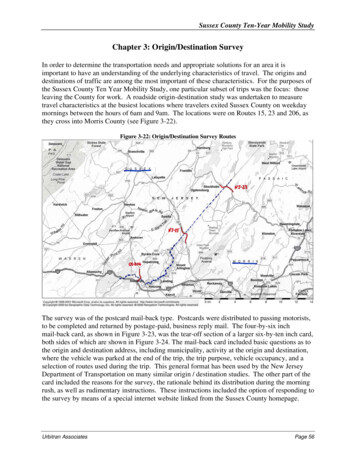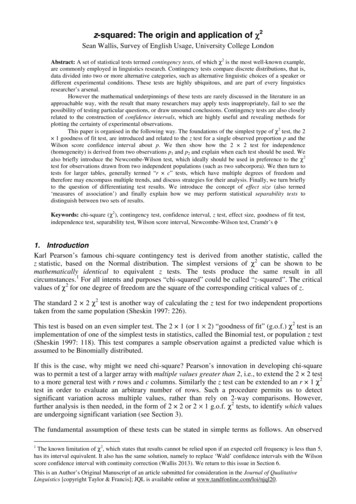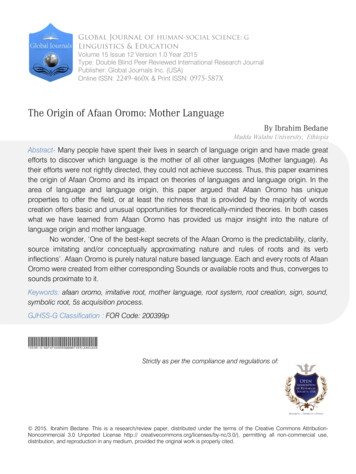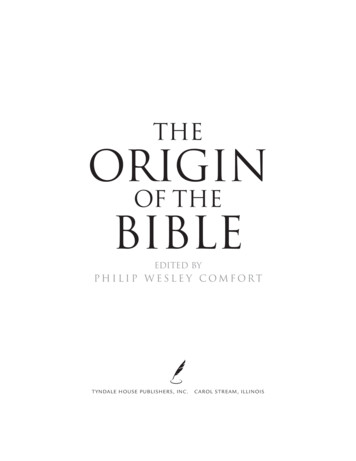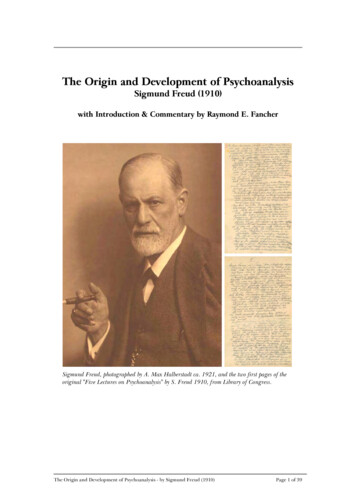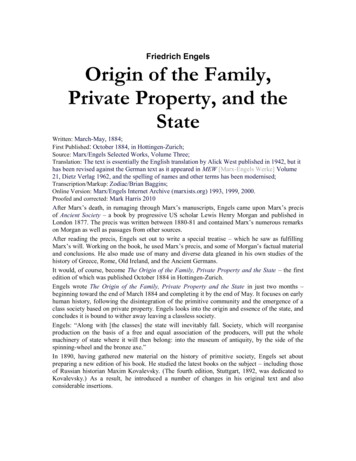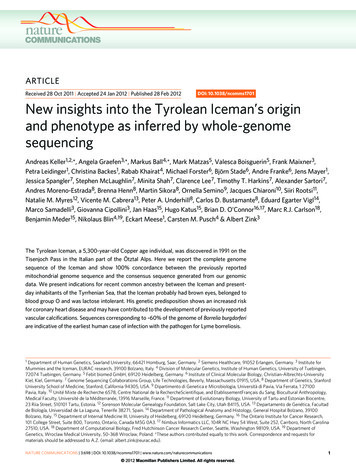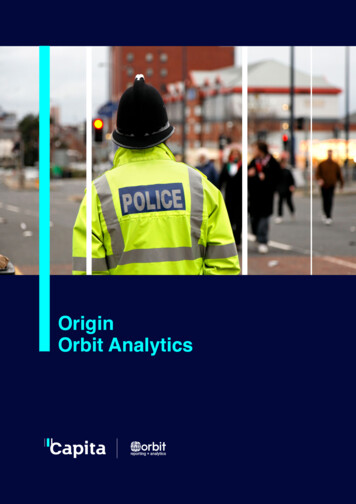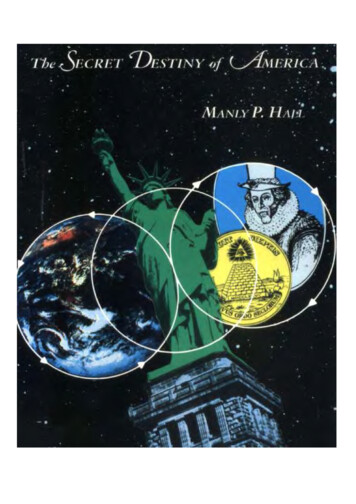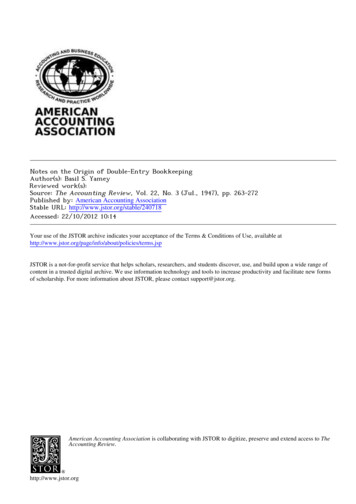
Transcription
Notes on the Origin of Double-Entry BookkeepingAuthor(s): Basil S. YameyReviewed work(s):Source: The Accounting Review, Vol. 22, No. 3 (Jul., 1947), pp. 263-272Published by: American Accounting AssociationStable URL: http://www.jstor.org/stable/240718 .Accessed: 22/10/2012 10:14Your use of the JSTOR archive indicates your acceptance of the Terms & Conditions of Use, available at ms.jsp.JSTOR is a not-for-profit service that helps scholars, researchers, and students discover, use, and build upon a wide range ofcontent in a trusted digital archive. We use information technology and tools to increase productivity and facilitate new formsof scholarship. For more information about JSTOR, please contact support@jstor.org.American Accounting Association is collaborating with JSTOR to digitize, preserve and extend access to TheAccounting Review.http://www.jstor.org
NOTES ON THE ORIGIN OF DOUBLEENTRY BOOKKEEPINGBASIL S. YAMEYTHEFACT THAT THE origin of doubleentry bookkeeping remainsshroudedin mystery does not detract from themerits of the valuable researches into theearly history of accounting made by several scholars. In the nature of thingsattempts to probe the origins of the technique are at best intelligent guesses or inferences. The search provides an interesting pursuit for the historian even if heknows that the spoor will disappear,sooneror later, in a confused tangle of speculation and conjecture, with the scent of redherring always present. The followingnotes deal with one of the possible trailsto the unknown origin; or rather, a possible trail provides a tenuous centraltheme about which some observations arepresented.A POSSIBLE LINE OF APPROACHAccounting resembles crafts in so far asit consists of techniques designed to servecertain practical ends. The methods andinstruments of crafts generally undergo acontinual though often almost imperceptible process of change. The discovery ofnew media,I the influence of particularcraftsmen,2 chance circumstances, or theI As an example of a new medium, the possible effects of the introductionof Arabicnumeralsupon bookkeeping technique may be mentioned. The view haseven been expressed that Arabic numerals are indispensablefor systematisedbookkeeping,since the earlierRomannumeralswere, allegedly,unsuitablefor tabularrecordingand computations.On this view Spain,wherethe use of Arabic numerals was first introduced toEurope by the Moors, has been claimed as the birthplace of double-entry. (See Theodor Drapala: Diein ikrer wissenscbaflicken PfJege,Buchkaltungskunde1889, p. 68.) That this view is scarcely plausible maybe gatheredfrom the fact that Roman numeralswereused in double-entryrecords for some time after theadoption of the Arabic system of numeration,apparently in order to make the fraudulent alteration ofrecordsmore difficult.2 Thus the use of the "opening balance account,"which "has since become a regular feature of thebookkeepingmethods of practically the whole of Continental Europe"has been ascribedto Alvise Casanovacoercive urge of unfilled requirementsmay be the cause of these changes. Rarely,one would imagine, are the changes soradical that the continuity of the development is broken. Inertia and the belief inthe sanctity of earlier procedures oftenlead to the adherence to earlier practiceslong after they have ceased to serve anyuseful purpose.' It is likely that the majority of changes, when they do occur, takethe form of variations on the existing practice, by omission, simplification, additionor adaptation: the newly-evolved techniques closely resemblethe ones previouslyused, and their character is largely determined by them.Is it not possible or likely that mercantile accounting has evolved along the linessketched in the previous paragraph? Andthat the appearanceof double-entry bookkeeping is to be explained as one event,albeit a momentous one, in a gradual evolutionary process of development? RowFogo has expressed this view that bookkeeping "is neither a discovery . . . northe inspiration of a happy moment, butthe outcome of continued efforts to meetthe necessities of trade as they graduallydeveloped."4 Elsewhere I have queriedthis thesis that double-entry developed indirect responseto some particularbusinessneed(s), which was not adequately servedby earlier methods of accounting.5 Butin his Spechio lucidissimo (1558). (P. Kats: "JamesPeele's Maner and Fourme" in TL. Accountant, Vol.LXXXIL, 1930.)' Professor H. R. Hatfield has collected some of the"folk-lore" of double-entry bookkeeping, proceduresstill practised for no other reason than the magicalinfluence of custom, in his article, "Accounting Trivia,"in Accounting Review, September, 1940.4In Brown's A History of Accounting and Accountants, 1905, p. 93.' In The Functional Development of Double-EntryBookkeeping, Publication No. 7 of the AccountingResearch Association, 1940, reprinted in The Accountant, November 2, 1940.
264The Accounting Revieweven if my doubts are accepted as valid,the possibility of the emergence of doubleentry as the product of a gradual processof change still remains open; for changesin the technique of a craft are not necessarily nor solely caused by the stimulus ofnovel problems awaiting solution. At theother extreme changes may be initiatedalmost by accident.Here two sorts of bookkeeping, whichit is reasonably certain were practised before the appearance of double-entry, willbe examined to throw light on the questionwhether it is possible that double-entrydeveloped as an improvement or expansionof them, taking over some of their basicfeatures but representing a further stagein the process qf adaptation and change.The two sorts of bookkeeping are singleentry and agency or factors' bookkeeping,the main emphasis being placed on thesecond.SINGLE-ENTRYAND DOUBLE-ENTRYIt seems as if, before double-entry appeared, accounting records of proprietorships, whether single or multiple, were confined to records of dealings involving thegranting or receiving of credit. The recordsassumed various forms and often the"books of account" were mere scraps ofpaper. Sometimes there were entries indiaries or journals, where the settlementof debts was indicated by the effectivethough untidy method of deletion. Sometimes the entries in the journal were reclassified into accounts, the beginnings ofthe modern ledger.Though there is evidence that othertransactions were sporadically recorded,the scope of the early bookkeeping effortswas very similar to that of what is nowknown as single-entry bookkeeping. Butas the records were in no way systematized, it is perhaps incorrect to describethem as single-entry, which term todayimplies the presence of some system in therecords. Indeed, single-entry as a systemis more likely to have been a developmentfrom double-entry.Dr. Jager has stated that single-entry,as a system, developed out of doubleentry through the gradual omission of allimpersonal accounts.6 Schmalenbach saysthat "there existed in Germany, particularly in the Hanseatic towns and in theSouth German trade centers, before theadoption of the Italian bookkeeping, asystem of commercial accounting with afairly well-developed technique and nomenclature." He continues that doubleentry considerably influenced this nativebrand, "so that the single-entry bookkeeping methods of today have the appearanceof being stunted versions of double-entrybookkeeping."7 Also Flugel in his text,Der getreue und aufricktige Wegweiser(1741) states: "Here I have purposelydescribed double-entry first, because thisis the chief source from whence singleentry has sprung.'Professor Hugli disagrees with this opinion that single-entry as a system is derivedfrom double-entry by a process of attenuation. It is his view that "single-entry is nomere fragment, but in form and for itspurpose a complete and satisfactorywhole," and that "the natural development can indeed have been no other thanthat double-entry grew out of single-entryafter the latter had matured into a complete system."8 A subsidiary argument ofHugli's is that Luca Pacioli mentioned byname both single- and double-entry in thethirteenth chapter of his Particularis, thefirst printed work treating of accounting,thereby indicating at least the co-existenceof the two systems at an early date. However, it is clear that in the chapter concerned Pacioli was merely referringto two6 Altes und Neues aus der Buchhaltung, 1889, p. 3.7 Dynamische Bilanz, 5th. edition, p. 56.'s"Ueber die Geschichte der Buchhallung in Itlien"in Zeitschrififur Buchhallung, 1894.
Notes on the Origin of Double-Entry Bookkeeping265sorts of registers or indexes to the ledger,and not to two sorts of bookkeeping.9But even if a system of single-entrybookkeeping had existed before the emergence of double-entry, there is still a verywide gap between the two methods bothin scope and technique. The latter contains nominal and real accounts which theformer does not. The cohesion of the accounts in the latter is without counterpartin the former. It would require the introduction of deus ex machine of considerableproportions to explain how the two widelydissimilar systems are actually successivestages in the evolution of accounting methods. Professor Littleton has suggested oneway in which the gap may have beencrossed: the automatic, unreasoned extension of the practice of making dual entriesfor some transactions to all transactions.If a cash account is kept in conjunctionwith the personal accounts in a system ofsingle-entry, then the receipt or paymentof cash in settlement of debts would require two entries. Similarly, even in theabsence of the cash account, the substitution of one debtor or creditor for anotherwould require two entries in the personalaccounts. In Professor Littleton's words:"Once the practice of dual entries uponopposing sides of bilateral accounts hadbecome established, it would not be difficult to extend it by analogy to new accounts. No one would have to stop andreason out the philosophy of the matterfirst."'1"factor" or agency bookkeeping played asignificantpart in the emergenceof doubleentry. Briefly, the view appears to be thatagents had to keep accounts to show theirindebtedness to their principals;that theseaccounts assumed a distinctive form; and,that double-entry is a lineal descendant ofthat system.The bookkeepingaspects of agency maybe summarized by saying that the agentmust be able at all times to show to whatextent and for what reasons he is indebtedto his principal, or vice versa. The bookkeeping technique amounts to the keepingof a personal account in the name of theprincipal, debiting it with all expenses incurred by the agent on the principal'sbehalf, and crediting it with all the proceeds of the agency business received bythe agent. There would be no profit calculation, partly because the agent would notnecessarily know all the relevant facts(e.g., the cost of the goods he may receivefrom the principal), and partly because theprofit calculation would be irrelevant fromthe agent's point of view. The receipt ofgoods from the principal would not giverise to an entry in the principal's accountuntil the sale of the goods. The agentwould find a stores book with details ofquantity, disposal instructions, etc., usefulto keep track of different consignments.He would also find it useful to keep accounts of his cash transactions and creditdealings in connection with the agency.Dr. Mickwitz in an interesting studyhas shown'2 that this type of agency acAGENCY BOOKKEEPINGcounting is most suited for another typeIt is the contention of Dr. de Waal, supoftrading, which appears to have beenported to some extent by the views ofcommonamong the traders in the IlanProfessor Littleton and Mr. Kats,11thatseatic towns. He has described the pracI See Kheil's "Ueber einige Bearbeitungen des Buchtice as it prevailed in Reval in the fifteenthhaltungs-Tractates von Luca Pacioli" in Zeitschrift filrand sixteenth centuries. The form of tradBuchhaltung, 1895.Accouning Evolution to 1900, 1933, pp. 38-39.ing was a type of partnership between twoAn interesting conjecture on similar lines is put for10ward in the article on Bookkeeping in McCulloch'sCommercial Dictionary (New Edition, 1859).11P. G. A. de Waal: De Leer van het Boekhouden inde Ncderlanden tijdens de Zestiende Ecuw, 1927. A. C.1 8*Littleton: op. cit. P. Kats: "Early History of Bookkeeping" in Journal of Accountancy. Vol. XLVII, 1929.12Acas Revaler Handelsbilhern, 1938.
266The AccountingReviewmerchants, each in a different town, andeach sendinggoods to the other to be disposed of at the best price, profits beingsharedin a pre-arrangedratio. In such circumstanceseach partnerwas virtually thefactor for the partnership. There was nosingle centralized set of books, but eachpartner kept recordsof partnershiptransactions in which he had taken part. Eachpartner kept records of his expenses onaccount of the partnership, and his receipts from the partnership business. Abalance of receipts over payments wouldbe of almost the same significanceas theexcess of an agent's receipts over his payments, viz., indebtedness to an externalentity. The only differencewould be thatthe partner-factorhad an interest in theprofits made by the externalentity, whichwas calculated periodically by combiningthe separate recordsof the two partners.UndoubtedJy the bookkeeping adoptedresembles that of agents, and Dr. Mickwitz objects to the name "agents' bookkeeping" as a descriptionof the commonsystem, as being incorrectly restrictive inits title.Whetheror not agency bookkeepinghasbeen a stage in the evolution of doubleentry has been made by Dr. de Waal todepend largely, but by no means exclusively, upon the interpretation given tothe worksof ValentinMeanhervon Kempten, who wrote several texts on accountingpublished in Antwerp between the years1550and 1565. But beforediscussingtheseworks it is useful to go back to the worksof the earliest German write
Notes on the Origin of Double-Entry Bookkeeping 265 sorts of registers or indexes to the ledger, and not to two sorts of bookkeeping.9 But even if a system of single-entry bookkeeping had existed before the emer- gence of double-entry, there is still a very wide gap between the two methods both in scope and technique. The latter con-

